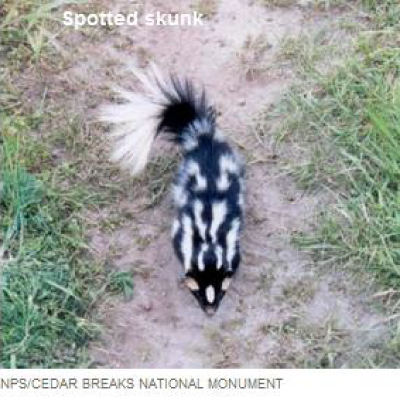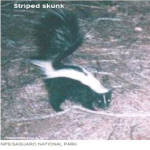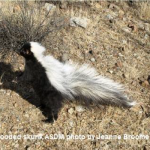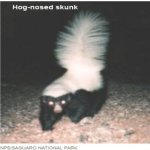
Skunks belong to the Mustelidae family which includes badgers, otters, ferrets, and weasels. There are four species of skunks in Arizona.
Skunks are nocturnal omnivores that eat anything including beetles, grubs, grasshoppers rodents, birds, carrion, seeds, and fruit.
According to the Arizona-Sonora Desert Museum,
Skunks live in a variety of habitats from riparian canyons and wooded areas to Arizona uplands and suburbs. They prefer thick, brushy areas. None of the skunks are common in the low, dry flats.
Skunks sometimes build their own dens, but often share the dens of other animals, particularly pack rats, or make use of other suitable sites such as brush piles, hollow logs, boulder piles, mine shafts, or underneath buildings. Their dens don’t smell like skunk spray, but do have a distinctive, strong, musky odor. Although they don’t hibernate, skunks gain extra weight in the fall, which tides them over the lean times during the winter. They retire underground for as many as several days at a time during cold winter storms.
The spotted skunk is the only one able to climb trees, which expands its foraging opportunities. This small skunk breeds in September and October, but delayed implantation results in the young being born in May. The other skunks all breed in the spring, with most babies born in May. The 3 to 7 kits stay with the mother through the summer, accompanying her on nocturnal hunting forays, before dispersing in the fall. Evidence of skunks in an area includes many divots in the earth and other signs of rooting, as well as scat containing berries, insect parts, and bits of fur.
The black and white coloring of skunks, called aposematic coloring, serves as a warning to potential predators. Only the great horned owl, which has a very bad sense of smell, will prey on a skunk.
Skunks seem to know they have a formidable defense; they have enough fluid for five or six volleys and can spray up to 12 feet. Skunks are not nearly as skittish as badgers for instance. Skunks will give you a warning before spraying. Most will stamp their feet. The spotted skunk will even do “hand stands.” Skunks have a waddling gait because they walk flat-footed on their hind feet.
Here are the four Arizona skunk species:
Striped skunk:
Total length: 20 – 31in (52.2 – 80cm)
Weight: 6 – 10lbs (2.7 – 4.5kg)
The Striped skunk is the most common and generally the largest, about the size of a cat. It occurs throughout Arizona. There is some variation in pattern. There is a thin white stripe on the face. The tail is slightly shorter than the body.
According to AZ Game & Fish: “These skunks are active throughout the year and do not hibernate even in northern Arizona; the males instead form communal dens with several females.”
Total length: 22 – 31in (55.8 – 79cm)
Weight: 6 – 10lbs (2.7 – 4.5kg)
The Hooded skunk has two phases, a white phase where the back is completely white, and a dark phase where the back is black with two white side stripes. The tail is longer than the body and very lush. It occurs in the southeast quarter of Arizona and in parts of New Mexico and Texas.
Hog-nosed skunk:
Total length: 20 – 36in (51.3 – 90cm)
Weight: 5 – 10lbs (2.3 – 4.5kg)
The Hog-nosed skunk has a large fleshy nose which it uses to grub for insects. The tail is shorter than the body. Long claws look bear-like.
It ranges throughout southeastern Arizona and follows the Mogollon Rim in a narrow band to the northwestern part of the state.
Spotted skunk:
Total length: 13.5 – 18.7in (34.3 – 47.5cm)
Weight: 1 – 1.5lbs (2.2 – 3.3kg)
The spotted skunk is the smallest of the four, about squirrel size. Its tail is black at the base and white on the tip.
This is the only skunk known to climb trees and is the fastest of the four skunks. It has been reported in every Arizona county.
About the odor (according to the Yavapai County agricultural extension):
If you get sprayed, the odor can be reduced with the following formula. Mix together 1 quart of 3% hydrogen peroxide, 1/4 cup baking soda, and 1 teaspoon liquid soap. Apply while the solution is bubbling and rinse with tap water. Diluted solutions of vinegar or tomato juice also have been used to eliminate most of the odor from pets, people, or clothing. Clothing may be soaked in a weak solution of household chloride bleach or ammonia. Neutroleum alpha, a scent masking solution, can sometimes be obtained from commercial cleaning suppliers.
Where musk has entered the eyes, severe burning and an excessive tear flow occur. Temporary blindness may result with sight returning in 10 to 15 minutes. Rinsing the eyes with water will speed recovery. Contact your physician if pain persists.
Articles on other Creatures of the Night:



